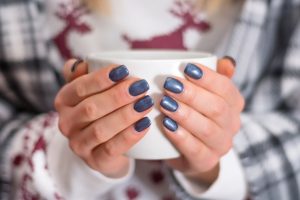Temperature Changes and the Effect on Acrylic Nails

Temperature Changes and the Effect on Acrylic Nails
If you’re looking for signs that the seasons are changing, the first post-summer snowfall is usually a pretty obvious one. As we’ve just gotten our first snowfall marking the start of some real cold weather ahead, we wanted to address a question we get asked frequently, around this time of year:
Why is your acrylic liquid and powder not setting right?
Nail technicians and salon owners have been using the same products for months on end, but suddenly they’re not setting the same way. Acrylics are an art heavily based chemistry; like chemistry all impacting factors need to be controlled to provide consistent results. Of course, consistently using the same products is one area of controlled factor, but *temperature* is the one piece most commonly overlooked, because it isn’t visual/can’t be physically seen. The following three areas are the most major points where temperature can be addressed:
Salon Environment
Keep your salon at a steady, consistent temperature all year. This is absolutely easier said than done, but it is an important factor (for more than just comfort) when performing acrylic enhancements. Many owners like playing an energy conservation/electric bill game and turn their temperature controlling apparatuses down/off when they leave for the night. In the winter, this makes your closed salon colder, and in the summer it gets hotter. Nobody is there to notice the difference, and it save money on the monthly bill, so it seems obvious that one should do that, right? The missing piece that could help determine whether or not that’s a good strategy is to remember that products inside that environment are also going to change temperature, and the expected performance may be compromised. Products take longer to acclimate themselves to an environmental temperature than the air itself does. Even if you’re going to want to cutback on your energy consumption during months of extreme temperatures, you’ll need to allow the product time to get back to performance temperatures before attempting to use them, or you may experience unreliable set times and other unnecessary difficulties.
Products
The first important piece to note here regarding products is simple. There are powders that are strategically formulated to provide consistent results depending on the climate, and there are other powders that are made called “All Season.” While it may be very true some powders work all year for the environment where they are made, it may not be true for you where you are.
Especially in the USA, we have drastically different expectations with regional temperature changes as seasons transition. A Minnesotan might wear short sleeves in 40° weather while an Arizonan would reach for a coat; conversely an Arizonan knows how to handle 120° because that’s expected during their summer months. So, since temperature plays such a large factor in curing times for acrylics, what exactly does “All Season” mean for your product? You may use the same product year-round, but chances are you’re may also have to change your liquid to powder ratios and expectations of curing times could turn into an uncomfortable game of guess-and-check.
We want to make it simpler for our customers world-wide, and so we offer three different setting speeds for our powders – Standard, Fast and Very Fast – that way you’ll never have to change your liquid. This Liquid is an all-season product. Nomma Plus is a technologically advanced liquid that utilizes advancements made to combat common complaints from nail techs, of which Crystallization is certainly one in the winter months where we’re from (West Chicago, Ill). If you’re having problems with cold temperatures, we recommend using our Nomma Plus® liquid with our Fast setting Crystalfree, Advanced Fast or Very Fast setting Aqua powders.
Even if you don’t want to change your type of powder, there are ways to adjust speeds with the ones you already have. Ideally, acrylics work best at an ambient temperature consistently comfortable for a room: typically, 74°F – 75°F. Every degree of variance from that constant will influence curing times. The colder you stray from that steady and reliable point, the slower the reaction will be; on the other hand, the warmer your products are the quicker they will cure. Many technicians keep a bowl of warm water at their station to put their dappen dish in; this gently changes the temperature of the liquid. Others like to put their powder under a light to make that warmer too. In some cases, people can and have done both.
Whatever it is that you’d choose to do, there is one thing that absolutely is NOT recommended:
Most important warming warning…. DO NOT MICROWAVE PRODUCT!
Client’s Hands
Since every degree can make an impact on the performance of the products used in acrylics, it’s important also to consider the temperature of the location where the acrylic curing process actually needs to happen – the working canvas for your art – your customer’s hands! Now that your Salon and your products (even in storage) are being kept at a steady temperature, you need to get your customers hands back to a normal regulated temperature. In summer months, their hands might be too hot making the acrylic cure too quickly; in the winter, their hands may be very cold – especially if they haven’t been wearing gloves.
A simple (and somewhat sneaky) way to acclimate your customer’s hands to a regular temperature is to offer your customer a seasonally appropriate beverage – hot tea in winter, or a cold water bottle in summer. This accomplishes two things: 1) they’re thrilled to get a warm beverage on a cold day, 2) they don’t know you did this so they’d hold a hot cup and warm their hands so your art could be more consistent.
TL; DR
Things you can do to control temperature changes:
- Keep your salon, and your storage areas at a consistently ambient temperature.
- Make sure your products are at an ambient (or regular) temperature.
- Make sure your customer’s hands are at a normal body heat range, neither too hot nor too cold!
